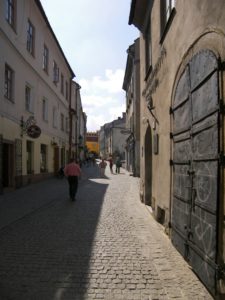
In order to know the Jewish culture of our region we need to be familiar with the past. The first Jewish settlers came during the Middle Ages; with time, Jewish population rapidly increased as a result of Polish religious toleration. In 1939, there were about 25.000 Jews living in Tarnów (45% of town’s residents). A significant part of them constituted the intellectual and cultural elite of Tarnów as lawyers, physicians, musicians, teachers or entrepreneurs. The majority of Jews, however, were very poor and lived in crowded back-alley apartments, wooden houses and annexes.
The city was once an important center of religious life, maintaining few synagogues and over a dozen small prayer houses known as shtiebel and kloyz. There were Jewish schools, presses, cultural and social organizations, and a rich social life. Today, there are so few Jews in our region that it would be impossible even to gather a minyan; an assembly of 10 adult male Jews (over 13), essential to say public prayers in a synagogue.
Although the Jewish population has severely decreased since the time before WWII, their community has left permanent and esteemed mark on the Polish culture. Cemeteries are the most numerous monuments of the Jewish presence in our region, but the synagogues, schools, baths, archives and places commemorating holocaust remain as the strongest testimonies to Jewish contribution. The most interesting exhibits are the collections of the Regional Museum in Tarnów and museums in Dąbrowa Tarnowska and Bochnia. The museum in Dąbrowa Tarnowska is especially interesting as the last private prayer home in the region, preserved as museum after its last owner’s death.
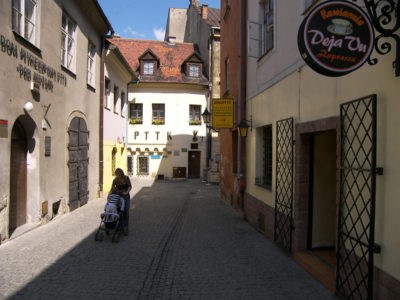
Żydowska and Wekslarska Streets – Well preserved 17th and 18th century tenement houses comprise compact settlement with narrow passages and halls and small yards that represent type of architecture specific to the Jews living in Tarnów. Narrow front walls, rare in the western part of the Old Town create a unique atmosphere of the street. Name of the street – Żydowska (Jewish Street) originates from the place where the first Jews started to settle in the second half of the 15th century. Being allowed to reside within dedicated quarter of the old town only, they had to adjust their buildings to limited space. These were the Jews from the oldest district who at the beginning of the 19th century started to settle in Grabówka district, on the east side of the town. Some of the houses preserved the iron shutters of Jewish shops once located inside. Also, on a few door frames one can discover traces of mezuzahs (a scroll of parchment containing two parts of Torah). A census from 15 October, 1785 revealed that 75% of old town residents were the Jews.
The oldest record documenting Jewish owner of a realty in the Town Square, dates back to 1791 when Aron Garfunkel bought Jacenty Majewski’s house No 58 at an auction. Located in the eastern frontage, the house survived until today, but was renumbered as 16. Twenty-three years later, as the then-created plan of the town unveils, few more houses in the Town Square were owned by the Jews. The lot and house No 17 belonged to Nathan Arzt, Berl Sax owned house No 11 and part of house No 19 (the one without arcades) was the property of Joseph Stubenreich. In the second decade of the 19th century, Jewish settlement expanded consistently towards pl. Rybny, ul. Zakątna and into Town Square. Most of the poor Jews, however, lived in small apartments in the oldest Jewish district of the town outlined by Żydowska and Wekslarska streets. In following few decades, rapidly growing Jewish population settled mostly the eastern part of Tarnow: Grabowka district and along ul. Lwowska. In the result, Tarnów evolved into bi-cultural Polish-Jewish city. Immediately before WW2, some 45% of the town’s residents were the Jews. Town Square witnessed the martyrdom of local Jews during German occupation. From June 11 untill 19, 1942 the Germans executed nearly 3.000 women, men and children. On the corner building of Żydowska Street, a plaque commemorates Tarnów victims of the holocaust.
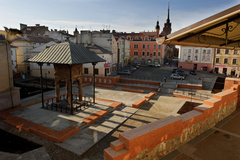
One of the most important monuments of Jewish culture is the Bimah (Almemar), a podium in the synagogue from which Torah is read. The Bimah is all that remains of a brick synagogue built in 1661 and burned down by the Germans on 9th of November 1939. The original structure, most likely made of wood, was vulnerable to fire. Frequent conflagration urged the Jewish society to replace existing construction with a brick building. The remained Bimah is composed of four pillars carrying square block. The ceiling was covered with stucco. Small pieces of the decoration are still visible. In 1987, the Almemar has been roofed. It is the site of annual “Galicianer Shtetl” – Jews of Galicia Remembrance Days.
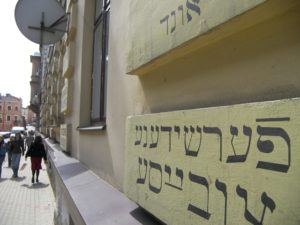
Goldhammera Street – named after Dr. Elijah Goldhammer, an attorney who was the vice-mayor of Tarnów from 1906 to 1911. The last prayer house, under custody of the last Jew – Abraham Ladner, was located in the house number 1. Ladner’s death in 1993 marked the end of five-hundred-year-old common history of Jews and Poles in Tarnów. The next building, number 3, is the former hotel of Herman Soldinger, one of the best hotels in the city. During the German occupation it was changed into a hotel for German soldiers on vacation. After the war it became again a Jewish center as the religious community and the first prayer house were settled there. Building number 5 housed former Jewish Credit Society whose Supervisory Council President was Herman Merz. In the hall there are two commemorating plaques dedicated to Merz and Goldhammer. Opposite, on the front wall of house number 6, partially preserved inscription, written in both Yiddish and Polish, advertises menu of a restaurant once located here.
The corner of Nowa and Waryńskiego Streets was once full of institutions which guaranteed proper functioning of the Jewish community. The western corner of Nowa Street was occupied by kahau building, that is the Israeli community in Tarnów. Next to it, a small Debora Menkes’ (Wekslerowa) – the benefactor of the Jewish community and founder of the Jewish hospital, house of prayer was located. In the eastern corner of Nowa Street, at the intersection with Waryńskiego Street, the greatest of Tarnów’s synagogues stood. It was called New or Jubilee Synagogue. The construction works last for nearly sixty years (1848-1908) and the prayer house was finally opened to the public on 18 August, 1908, on Emperor Francis Joseph’s birthday – hence the name Jubilee. Its original shape and the golden dome rising above the town were pride of Tarnów Jews. Unfortunately it was opened for only thirty-one years before, as all other synagogues in Tarnów, it was burnt down by the Germans on 9 November, 1939. It was burning for three days. In September 1993, a commemoration plaque was placed on the front wall of a house which replaced the synagogue.
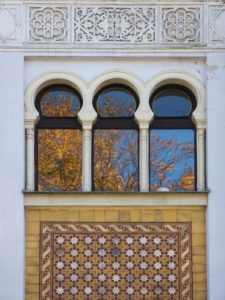
Mikvah – Jewish ritual bath house. The building was designed by Franciszek Hackbeil Sr. – a constructor from Tarnów, who in 1900 set a company with Michał Mikoś in order to built a bath house. It was to be located on the former Dożywocie Square (Lifetime Square). The bath house, built in a Moorish style, was opened in 1904. On 13 June 1940, 753 convicts from the local prison were locked in this building by German Soldiers. The following morning they were drew out and and escorted by armed gendarmes to the railway station in Tarnów, where they were put into cars and transported to the Auschwitz concentration camp. Only 728 reached the destination and about two hundred managed to survive the camp. Those prisoners, called the Tarnovians, were given the lowest camp identification numbers starting from 31 to 758.
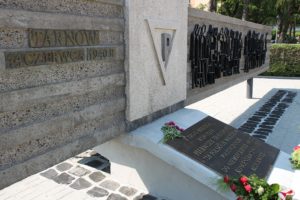
The square opposite the bath house (its present name: Square of the Prisoners of KL Auschwitz) shelters the commemorative monument by Otto Schier. It has been renovated just recently, introducing some new elements (original cobble stones dated to the 1940s, eternal flame) and inscriptions.
Square of the Ghetto Heroes
Now Square of the Ghetto Heroes, formerly Oak Square. In the place where the square and Walowa Street meet, the biggest gate of the ghetto stood, guarded by armed German gendarmes. The second gate was on Folwarczna Street, now Warynskiego Street, in the place where it crosses with Kupiecka Street. The ghetto was not established directly after the start of German occupation on 7 September 1939. The Nazis were dealing with twenty five-thousand of Jews and they presumed that the number would increase due to displacing people from nearby villages. Thus, at first, only the mobility of the Jews was restricted to the borders of their old districts. However, as a result of mass murders and numerous transports to the concentration camps the number decreased and a fenced Jewish ghetto was established. It was surrounded by the Oak Square, Walowa, Lwowska, Nowa, Mickiewicza, Starodabrowska and Polna Street. The ghetto area originally reached Jasna Street in the east but was regularly reduced.
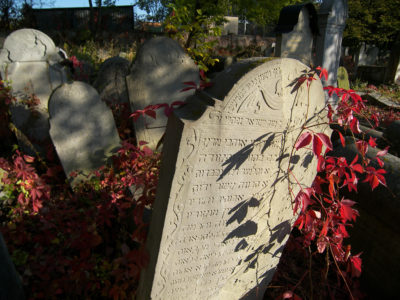
Jewish cemetery – located near the intersection of Słoneczna and Matki Bożej Fatimskiej Streets. the largest, oldest and best preserved cemeteries in southern Poland. It occupies an area of 3.20 hectares, and has about six thousand tombstones, of which the oldest date back to the 17th century. Most of the gravestones are greatly ornamented and rich in symbols. On some only traces of polychromy were preserved. Tombstones have Hebrew, Polish and German inscriptions. The cemetery was established in the 16th century (first written information comes from 1581) on the premises of the former Pogwizdów farm. Devastated by the Germans during occupation it was, between June 1942 and September 1943, a place of mass slaughter of the ghetto Jews.
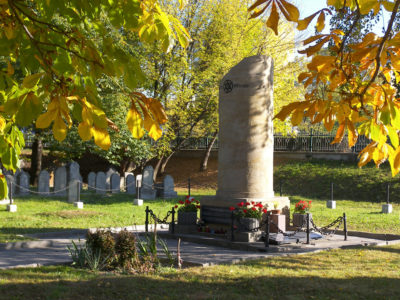
After the war, in 1946, Jewish sculptor Dawid Becker designed a monument – a broken column from the remains of the New (Jubilee) Synagogue and located it in the place of the victims’ mass grave. The inscribed quotation “And the sun shone and was not ashamed…” was taken from a poem of Nahman Bialik written after the slaughter of Kishniev Jews in Ukraine in 1903. Since 1989 the City Council and the Committee to Protect Monuments of Jewish Culture in Tarnów have been taking care of the cemetery. It was enrolled in the national monuments register. The cemetery fence was rebuilt, wild bushes and weeds were removed and the graves are still being fixed. Among the tombs there are well preserved graves of rabbis, judges, artists and Zionism activists. There also is a quarter of Jewish soldiers from the Austro – Hungarian army, who died in a nearby hospital during world war one. The original prewar iron cemetery gate was donated to the Holocaust Memorial Museum in Washington by president Lech Wałęsa, during his visit in the USA in 1991. The gate is one of the largest objects in the Museum. The Jewish Cemetery in Tarnów is an open necropolis, managed by the Jewish Community of Kraków. Committee for the Preservation of Jewish Cultural Monuments in Tarnów carried out renovation of selected tombstones. The cemetery has a monograph by Leszek Hońdo entitled “Jewish Cemetery in Tarnów”, as well as dedicated mobile app.
Ochronek Street – the Michalewicz Workers Home, built by the socialist Bund party which operated there. Still farther, on the left side is a former luggage factory which was once owned by Krzak and Szpiller.
Szancer’s Mill. Henryk Szancer (1825-1885) was born in Zywiec. He came to Tarnow via Zabno and opened a steam mill in 1846. On 24 November 1859 Szancer and his partner Wilhelm Freund opened the first semolina steam mill in Galicia and quickly increased its production, influencing the modernization of mill industry in Galicia. Szancer and Freund built similar mills in Przemysl, Stanislawow and Bochnia. In 1865 they activated together the second steam mill in Tarnow. In the 80’s of the 19th century the mill in Tarnow paid eight times as high taxes as mills located in Prussian Gorny Slask, which proves the real scale of this investment.
Henryk Szancer was also a respectable benefactor, a member of the Town Council and was given a diploma of Tarnow honorary citizenship. As a token of gratitude for his service he was decorated by the Austrian emperor Francis Joseph with a medal of his name. After his death, he was buried in the Jewish cemetery in Tarnow, where his tombstone is still preserved. Beside the Hebrew inscriptions on his grave there is also a Polish text. It is probably the oldest Polish writing in this cemetery. The inscription and Polish spelling of the name may prove the Szancers’ assimilation to Polish culture.
Sienna Street – the tall building of the Talmud Torah, which is currently a nursing school.
St. Westwalewicza Street – the Baron M. Hirsch School was located there; today it is the Secondary School of the Arts.
Nadbrzeżna Street (Bank Street) – running along the Wątok where there once stood a Jewish ritual slaughterhouse. Here, over the stream on Jewish New Year (Rosh Hashanah) one can meet crowds of Jewish pilgrims saying traditional prayers.
Safa Berura Association Building. Thanks to the efforts of Public and High School Jewish Society Safa Berura (Pure Language), existing from the beginning of the 20th century, a public school was established in 1923 and a private coeducational gymnasium was set in 1927. The gymnasium had a great library with a few thousands of volumes and highly educated teachers, who, with some exceptions, had full academic and pedagogical qualifications. The Jewish gymnasium had a Zionistic profile, thus the students were prepared to take part in Israel’s reconstruction. Apart from that, the school, as other similar institutions, provided the learners with general secondary education, including Hebrew, elements of ethics and Jewish history. Polish was a lecturing language, however the issues of Judaism were taught in Hebrew. The Nazi authorities decided to close the school in 1939. In the last year it was attended by 243 students. After the war the building was used as an inter-school dormitory.